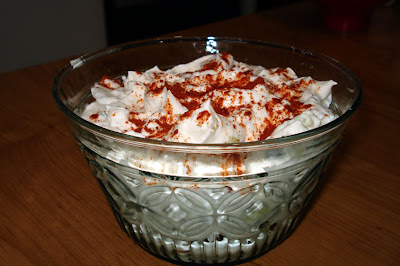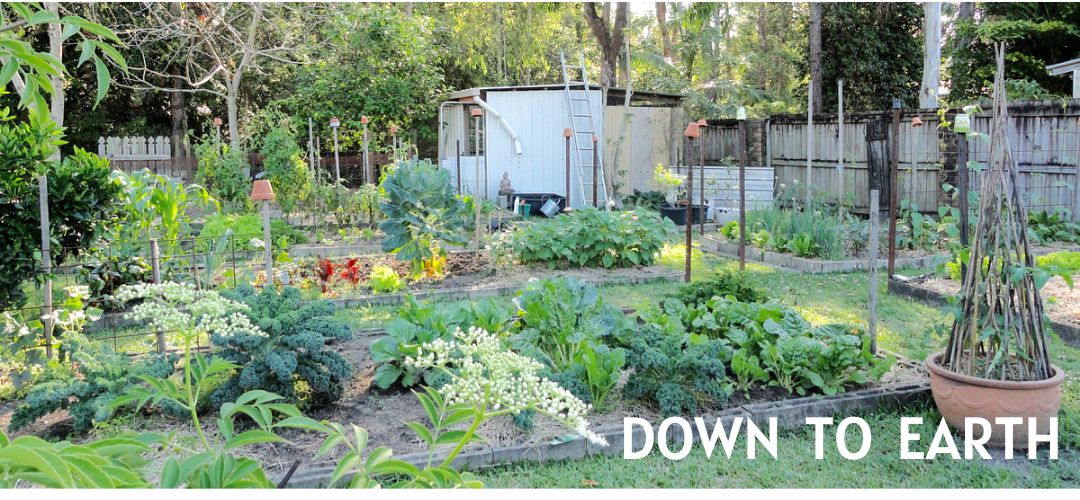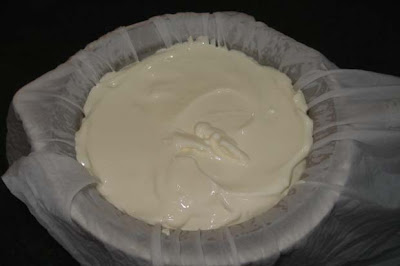Yesterday we had a 500gram/16oz tub of yoghurt that cost $3.50 and turned it into two litres/quarts of yoghurt that cost about $4. One litre/quart of that was eaten as yoghurt - with one cup reserved to make the next batch, the other litre/quart was made into quark cheese. Quark is a simple fresh cheese that doesn't require any special equipment and will be ready for eating as soon a you finish making it.

Above is quark made on the weekend. I added finely chopped cucumbers that had been salted and allowed to drain for an hour, pepper and topped it with a sprinkling of paprika.
QUARK
When you have your yoghurt made and you want to make quark, you need a large jug, a strainer and a piece of clean cotton cloth. Wash the cloth with pure soap, rinse well and wring it out so it's not dripping wet. Place the strainer in the jug and the cloth over the strainer. Then add the yoghurt.
Cover the yoghurt with the cloth, so the mix is entirely covered.
Put a plate on top and and weigh the plate down with something fairly heavy. I have used a pot of jam. The process of making quark involves removing the water (whey) from the yoghurt. You do that by sitting the yoghurt in the strainer, in the fridge, weighed down so the whey can drain from the yoghurt into the jug.
To get a suitable dry quark, you'll need to allow it to drain for at least 24 hours, possibly 48 hours. When you think it's able to be moulded into a cheese shape, remove the quark from the strainer, pack it into a mould and then turn it out onto a plate.
The quark below is an old photo of quark I made a few months ago. The savory quark was made by adding salt and pepper to taste to the finished quark and adding some chopped chives. You could also add chilli or chilli sauce over the top of the quark.
The quark below is an old photo of quark I made a few months ago. The savory quark was made by adding salt and pepper to taste to the finished quark and adding some chopped chives. You could also add chilli or chilli sauce over the top of the quark.
This sweet quark below was sweetened with a little honey and then I added a small amount of homemade strawberry jam to the top of the quark.
Whey is a by-product of quark. It is the fluid part of the yoghurt that is full of live lactobacillus acidophilus and is very good for you. You can use whey in a number of ways, don't throw it away. (<- Nice sentence there.) Whey makes a nice drink, you can drink it as is or when it is cold. It could also be added to smoothies. It is an excellent replacement for milk in any baking you might be doing. Whey will give you a great result in cakes, scones or biscuits. It can be added to sauerkraut, relish or pickles to add live culture to those foods.
You can also use it to make ricotta. You need an awful lot of whey to make ricotta. It takes the whey from 5 gallons of milk to make 1 kilo/2 pounds of ricotta, so I use the small amount of whey I usually have in another way. BTW, if you want to make ricotta and you have such a quantity of whey, go here to find out how to do it.
RICOTTA
1 litre/quart milk - can be fresh cow's, powdered, UHT or goat's milk
2 tablespoons lemon juice or cider vinegar
whey
If you want to use the ricotta for a dessert, you may like to add one cup of cream for a creamier ricotta.
Place all ingredients in a heavy bottom saucepan and heat up to simmering point. Don't boil it and don't allow it to burn. Stir to prevent scalding the milk. Soon after you add the acid (lemon/vinegar) you will notice the curds separate from the whey.

Prepare a strainer with an open weave cotton cloth in it, in the same way you did when making quark. Place the strainer over a large jug with the cloth in the strainer. Take a slotted spoon and add the curds to the strainer and allow the whey to drain into the jug. This will take a few hours for a dry ricotta and maybe one hour for a smooth creamy ricotta suitable for dessert. When it's drained enough, wind the top of the cloth around so you can give it one last squeeze, then the ricotta is ready for use. I used mine in lasagna. It freezes well so you could wrap it in plastic wrap and freeze it or store in the fridge for a day or two. It won't keep longer than that in the freezer.
The leftover whey doesn't contain much protein now, but you could still use it in baking. I give it to the chooks as an extra treat - we soak old bread in the whey and the chooks love it.
I hope you try these cheeses. They will be a healthy addition to your kitchen and another way you can be a self reliant cook. Don't forget that you can use any milk from fresh raw milk to UHT milk. Often that decision is made for you because you have to use the cheapest option. The raw milk will be live and the UHT will be sterile but you will still get good cheese no matter what you use.
You can also use it to make ricotta. You need an awful lot of whey to make ricotta. It takes the whey from 5 gallons of milk to make 1 kilo/2 pounds of ricotta, so I use the small amount of whey I usually have in another way. BTW, if you want to make ricotta and you have such a quantity of whey, go here to find out how to do it.
RICOTTA
1 litre/quart milk - can be fresh cow's, powdered, UHT or goat's milk
2 tablespoons lemon juice or cider vinegar
whey
If you want to use the ricotta for a dessert, you may like to add one cup of cream for a creamier ricotta.
Place all ingredients in a heavy bottom saucepan and heat up to simmering point. Don't boil it and don't allow it to burn. Stir to prevent scalding the milk. Soon after you add the acid (lemon/vinegar) you will notice the curds separate from the whey.

When you notice small bubbles form it's hot enough. Turn off the heat and let it sit in the saucepan for 30 minutes.
Prepare a strainer with an open weave cotton cloth in it, in the same way you did when making quark. Place the strainer over a large jug with the cloth in the strainer. Take a slotted spoon and add the curds to the strainer and allow the whey to drain into the jug. This will take a few hours for a dry ricotta and maybe one hour for a smooth creamy ricotta suitable for dessert. When it's drained enough, wind the top of the cloth around so you can give it one last squeeze, then the ricotta is ready for use. I used mine in lasagna. It freezes well so you could wrap it in plastic wrap and freeze it or store in the fridge for a day or two. It won't keep longer than that in the freezer.
The leftover whey doesn't contain much protein now, but you could still use it in baking. I give it to the chooks as an extra treat - we soak old bread in the whey and the chooks love it.
I hope you try these cheeses. They will be a healthy addition to your kitchen and another way you can be a self reliant cook. Don't forget that you can use any milk from fresh raw milk to UHT milk. Often that decision is made for you because you have to use the cheapest option. The raw milk will be live and the UHT will be sterile but you will still get good cheese no matter what you use.








